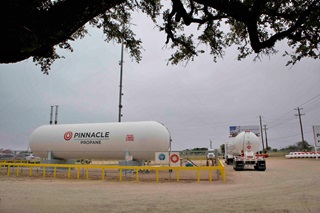The Ultimate Guide to Above-Ground Propane Tanks

An above-ground propane tank is a storage container designed to hold propane gas. Unlike underground tanks, which are buried beneath the surface, these tanks are installed, as the name suggests, above ground, making them more accessible and often easier to maintain.
Proper compliance with federal, state and local regulations is crucial when installing an above-ground propane tank. The main regulations include:
When considering an above-ground propane tank from Pinnacle Propane, the cost can vary depending on several factors. Here are some common factors that affect the price of your tank:
To get an accurate quote tailored to your specific needs, contact our sales team. Our representatives will help you determine the best tank size and features for your requirements.
Installing an above-ground propane tank involves several steps:
Above-ground propane tanks are built to last. With proper maintenance, they can have a lifespan of 20 to 30 years or more. Regular inspections and maintenance are vital to extend the tank's life and ensure safety.
Regularly inspect your propane tank for signs of wear and tear, which can include rust formation, dents, or visible damage to the tank’s structure. Discoloration or fading paint can also indicate exposure to extreme conditions that might compromise the tank's integrity. It’s crucial to monitor the areas around valves and connections for any signs of leaks or corrosion.
To ensure the safety and efficiency of your propane tank, adhere to the following maintenance tips:
Pinnacle Propane customers can schedule annual inspections to ensure their tanks are in optimal condition via the customer portal or by contacting the service center. Pinnacle adheres to strict inspection guidelines to maintain safety and compliance with regulatory standards. Additionally, we offer information on replacement costs and details about warranties for our tanks, ensuring that customers understand their options should a tank require servicing or replacement. It's always a good idea to contact us directly for the most accurate and detailed information regarding specific services and policies. This will help ensure that your propane needs are met safely and efficiently.
Pinnacle Propane offers tank removal services for customers who wish to discontinue use or need to replace their existing tanks. The cost of tank removal can vary depending on factors such as the size of the tank, the accessibility of the installation site, and local regulatory requirements that might influence the complexity of the job. Contact us directly for specific details about the removal process, including.
The decision depends on individual preferences, needs and property characteristics. Above-ground tanks are typically more cost-effective and easier to maintain, while underground tanks are less visible and less affected by weather conditions. Choosing between an above-ground and underground propane tank depends on several factors:
Reach out to us today so we can discuss your needs and help decision which option is right for you and your property.
Yes, above-ground propane tanks are safe when installed and maintained correctly. Adhering to regulatory requirements and routine inspections ensures their safe operation. Visit our safety page for more information.
Above-ground propane tanks offer a practical and efficient solution for storing propane gas. Strict regulations govern them to ensure safety and functionality. By understanding the costs, installation process, life expectancy and maintenance needs, you can make an informed decision about whether an above-ground propane tank is right for you. For more information and expert guidance on propane tanks, reach out to Pinnacle today and see how we can assist you in all your propane needs.
